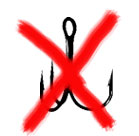

The yellowtail kingfish were in plain sight in the berley (ground bait) trail. Not big kingis, maybe up to 15kgs (30lb) by a generous, anticipation-filled guess. Not really big, but a good test, maybe too good a test for the salt water fly rod clutched in my hand. My excitement rose rapidly - too rapidly.
Standing precariously in the wobbly 'tinny' (Kiwi speak for an aluminium dinghy), I reared the rod back into the back cast; the line arced upwards and back behind me, pulling a good bend into the fly rod. Then I lunged into the forward cast, lunged early, far to early. The line collapsed around my head and into the boat, the fly embedding itself into the back of my jersey.
Removing a hook from a woolen jersey is not one of life's more memorable pleasures. Wool has fibres specially and specifically designed to hook a hook.
My view of sheep in a paddock is not the usual Kiwi one. It is the view of every fly fisherman who has embedded a hook in the tangled web of intricacy that covers this animal's hide.
The enormous contribution this woolly hook-grabber has made to the New Zealand economy counts for nothing when my hook is inextricably ensconced in the treacherous tentacles that come from this stupid creatures back.
I did the usual arm-up-the-back dance trying to pull the hook free, nearly tipping out of the tipsy tinny, all the time wondering why I waste this time, every time. Then, of course, the jersey had to be removed, after removing the fly vest, after untangling the line from my head, neck, body, rowlocks, motor, tackle box, and floor slats, while watching the kingis darting through the berley trail.
Of course by the time this mess was un-messed the kingis were gone.
(Article continues below advertisement)
A good time to reflect on the rules of casting. Simple rules too often made complicated.
All casting, fly, surf, or spinning is simple and essentially the same. The rod must be 'loaded', that is bent by the weight or inertia of sinker, lure or fly line. The rod at the end of the forward cast, still bent, rapidly recovers its shape, read rapidly straightens, adding acceleration to the terminal tackle or fly-line, and adding more velocity to the bait, lure, or fly to where you want it to go.
A bow and arrow seems to provide a good analogy. The archer pulls back on the arrow, pulling back the bowstring, bending, 'loading' the bow.
The arrow is released and the bow rapidly recovers its former straight shape, pulling the bow string forward, pushing the arrow on its way to the target.
Assuming the bow is fully loaded, fully bent, the speed at which the bow recovers its shape determines how far the arrow will fly.
Good simple stuff. In theory! To repeat - the theory is, if you load the rod properly, you will maximize casting distance.
Light spinning rods provide the easiest, illustration of this principle. The tips of these rods are very flexible and easily loaded, or bent. A simple flick of the arm in a forward cast will send a lure on its way.
Because the tip is light it needs very little force to load. This is fine for relatively short casts, but less than ideal when extra distance is required or when casting into a strong breeze.
To achieve this extra distance requires small but important adaptations to casting technique. Firstly add another small cast, a back cast. Throw the lure back with a light flick of the arm and while the lure is still going backward pulling the rod tip into a bend, accelerate the casting arm forward into the forward cast, flick the wrist a tiny bit to increase the acceleration, and stop the rod, to a dead stop, at the end of the cast.
This short back cast, uses the momentum of the lure going backward to load the rod further into the butt section of the rod, using more of the rod, the more powerful sections of the rod, to snap the lure on its way.
(Article continues below advertisement)
In principle maybe, in practice, not so simple.
Most Kiwi surf casters use the old but highly inefficient overhead cast. In this cast the sinker is held off the ground behind the angler. The rod is swept over the head and forward into the cast.
This method is inefficient because only the weight of the sinker and bait is used to load the rod, and the weight of the terminal tackle does not become effective till some way into the cast.
Some anglers, using the overhead cast, try to increase casting distance by increasing the length of their rod. This only increases the inefficiency.
It is much harder to load a long rod through to the butt section using this method. Some increase may be gained in distance, but only because of the increased arc the rod tip travels.
Much better is to join your local surf fishing club and seek out someone who can teach you the 'Off The Ground" or "Pendulum" cast. Both these casts use techniques that swing the weight out and away from the rod before the forward cast is made, and use this backward momentum of the weight to fully load the rod.
A word of warning, both the Off The Ground and Pendulum casts can be dangerous. Please learn them from competent tutors.
(Article continues below advertisement)
In fly-rod casting two casts are made, a back cast and a forward cast. The back cast is a forward cast made to the rear. The line, straight in the water is pulled backwards, and using the grip of the water on the line, the rod is loaded as the line moves backward. Once in the air the line moves to the rear of the angler.
Once it has straightened behind the angler, the angler moves the rod forward into the forward cast. The momentum of the line moving backwards loads the rod for the forward cast.
The best method of loading a rod is to use the maximum momentum of the lure, sinker or fly line, moving as fast as possible away from the direction of the forward cast to come.
In fly-fishing this principle is vitally important. The faster the line is moving in the back cast, the more the rod is loaded in the back cast, the better the forward cast will be.
But here is the rub.
Too many fly casting books and videos have stressed that the line must be straight out behind the angler before the forward cast is made. What is vitally important is that the line must be not only be nearly straight, but it must be moving backwards when the forward cast is made.
If the line stops even for a moment, all the rearward momentum is lost, irretrievably, and the rod cannot be fully loaded on the forward cast.
It is better to begin the forward cast slightly before the line straightens out behind, than to have the line straighten out and stop in the air.
Another principal that applies to all forms of casting, is that at the end of the cast, forward or back, the rod must be stopped, dead.
Back to the bow and arrow for a tick or two. Once the arrow is released, the archer must hold the arm that is hold the bow absolutely dead still, until the arrow leaves the bow. If not the arrow will not fly accurately. If the bow is moved forward some power will be lost.
The same thing happens in casting a rod. If at the end of the cast, the rod is not brought to an abrupt dead stop, power will be dissipated and accuracy will be lost.
Hammering a nail into a wall is a good analogy. The hammer head is driven onto the nail with virtually no movement of the wrist. All the momentum of the hammer head is driven straight and powerfully onto the nail head.
If the hammer is cocked up or down during the final part of the stroke a bent nail, and bruised thumb is the result.
It is good practice to grab a short stick, ruler, what-ever, and practice this hammer blow action. Doing it often enough is a great rehearsal for when you get on the water.
Casting the distances you want, or where you want, is a matter of doing simple things right, every time. There is only one way to achieve this, and this is to practice. On a football field, in a park, at a nearby beach, river or lake.
The alternative, is like me, doing the angled-elbows dance of the desperate in a ducking and diving tinny. I have yet to learn that swearing loudly, obscenely and uselessly at my own stupidity has increased my casting ability not one little bit.

Article written by Tony Bishop
If you want fresh fish from catching to the table - chill out!

Keeping fish in top condition from the time you catch it till the time it is cooked is relatively easy, and oh, what a difference it makes to the taste.
It is a sad fact is that much of the fish served up by amateur fishermen is passed its used-by-date. By the time it reaches the table it is well on the way to being rotten. What a waste. But it does not have to be that way...
Better Bait Basics
Catch More Fish
How to get the best bait to catch more fish.

Fishing with bait is the most popular method of salt water fishing. But buying a block of frozen fish deemed not fit for human consumption to use to attract fish that should be, is not going to optimise your chances of success.
The days of whacking a hunk of any old bait on a hook and tossing it over the side and catching fish are long gone. Oh, sure you may luck out and park above a school of fish determined to take a trip to your fry pan - but not often.
Cubing or chunking for increased snapper catches
How to use a very effective and well-proven tuna fishing technique to catch more snapper
I had been doing some reading on tuna ‘cubing’ or ‘chunking’ (depending on whether the magazine was American or Australian) and a germ of an idea had formed.
The time for the idea to germinate had arrived.
How to Release Fish with the Best Chance of Survival

Don't be fooled, just unhooking a fish and throwing it back in the water is not going to ensure a fish will survive the catch and release.
Releasing fish correctly has become a very important factor in preserving fish stocks for the future, but it needs to be done correctly.
This article sets out 5 "release rules" that provide the maximum survivability for the fish. There is also a couple of extra 'rules' and links to more information.
